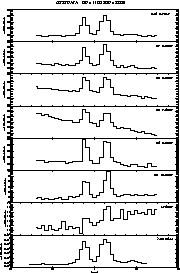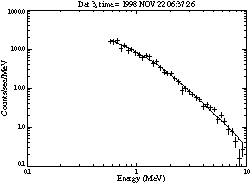Back To OSSE Solar Flare Web Page
1998 November 22 (X3.7)
A GOES X3.7 solar flare occurred on 1998 November 22. The soft X-ray flux began at 6:35 (23700 s), peaked at 6:45 (24300 s), and ended at 7:11 (25860 s) UT. The event was associated with AR8384 which was located at S27W82 at the time of the flare.
OSSE received a BATSE transient trigger at 23794 s UT while observing NGC 4945, but OSSE was not configured to respond because the Sun was too far off the scan plane during this observing period. The position of the Sun was off the collimator axis by ~40 degrees in the scan direction and ~15 degrees in the trans-scan direction resulting in strong attenuation of <1 MeV solar photons. However, the flare was intense enough to allow a significant fraction of the >1 MeV gamma-ray emission to penetrate the shields of the two lower detectors (detectors 3 & 4) and be detected. The two upper detectors were strongly shadowed by the two lower detectors. Because of the low-energy attenuation, the preliminary results presented here are based on an analysis of >0.55 MeV data only.
OSSE began detecting gamma rays from the flare at about 23795 s UT. Two peaks of emission were observed centered at about 23870 and 23970 s UT. Emission had decayed to insignificance by about 24020 s UT. Count rate time profiles in various energy windows at a temporal resolution of ~16 s are shown in Figure 1. Gamma-ray emission to energies greater than 16 MeV was observed. A 0.55-10 MeV count spectrum for one detector obtained from data summed over both peaks (23846-24010 s UT) is shown in Figure 2. No significant evidence for nuclear gamma-ray line emission was found. A power law fit to the >0.55 MeV data gave a >1 MeV fluence of 314 +- 12 photons cm-2 and an index of 2.46 +- 0.03.
 Figure 1 |
 Figure 2 |